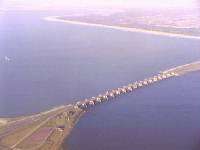Haringvlietdam
| Haringvlietdam | |
|---|---|
 | |
| Coordinates | 51°50′0″N 4°03′0″E / 51.83333°N 4.05000°ECoordinates: 51°50′0″N 4°03′0″E / 51.83333°N 4.05000°E |
| Carries | N57 |
| Crosses | haringvliet |
| Locale | Voorne-Putten / Goeree-Overflakkee |
| Owner | Rijkswaterstaat |
| Characteristics | |
| Material | Concrete, steel |
| Total length | 5 kilometres (3.1 mi) |
| Width | 56 metres (184 ft) |
| Longest span | 56.5 metres (185 ft) |
| Number of spans | 17 |
| History | |
| Construction begin | 1958 |
| Construction end | 1971 |
| Inaugurated | 15 November 1971 |
The Haringvliet sluices are a construction that closed off the estuary of the Haringvliet as part of the Delta Works. The structure consists of 17 sluices, several kilometres of dam and a shipping lock.
Building started in 1957 and was finished in 1971. Instead of damming the estuary it was decided to build sluices in order to be able to let in salt water to prevent freezing of the rivers Meuse and Rhine and to drain these rivers in case of flood.
The sluices have two doors each of which the door on the sea side is the lowest. This has been done to mitigate the effect of the waves on the doors and the construction.
There are plans to open several sluices permanently, resulting in the estuary function of the Haringvliet being restored. This will be done in order to improve the ecological situation in the river Meuse and Rhine. It will allow the return of brackish water (with the associated flora and fauna) and will restore the main route for migrating fish. It will also result in a minor return of the tides in areas like Tiengemeten and the Biesbosch, both important nature reserves.
External links
 Media related to Haringvlietdam at Wikimedia Commons
Media related to Haringvlietdam at Wikimedia Commons- Haringvliet Dam